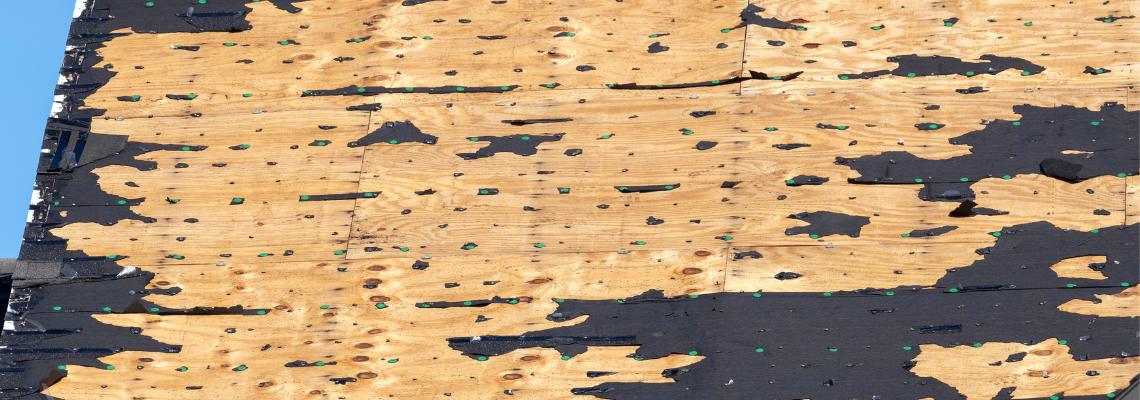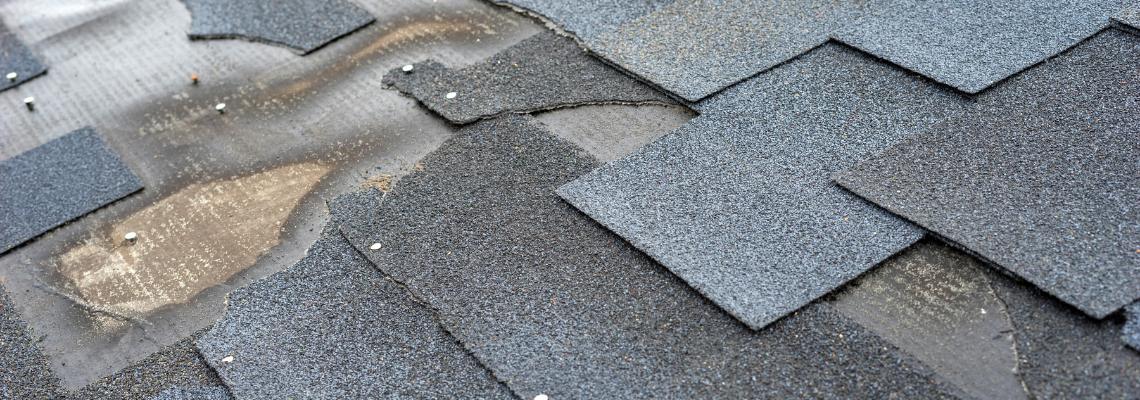Identifying Hail-Damaged Roofs: Repair or Replace
Experiencing a hailstorm can be a stressful event for any homeowner, especially when considering the potential damage it can inflict on your roof. Your roof serves as the primary shield for your home and family against the elements, making any damage a significant concern. Hailstones, which are frozen water drops, can range in size from tiny to pretty big and can have all sorts of shapes, like round or jagged.
Understanding the implications of hail damage on your roof is crucial, particularly in relation to your homeowner’s insurance coverage. While no one wants to confront the aftermath of a damaged roof, insurance policies are designed to mitigate such financial burdens. However, determining the extent of damage that warrants an insurance claim for roof replacement can be challenging. This raises the question: when should you fix your roof, and when should you replace it after a hailstorm?
In this guide, we’ll help you understand what to do after a hailstorm, explaining in simple terms how to tell if your roof needs fixing or replacing. This way, you’ll know what steps to take to keep your home safe and sound.
Understanding Roof Hail Damage and Its Impact on Your Property

Roof hail damage occurs when hailstones, formed from frozen water droplets in thunderstorm clouds, fall onto your roof. These hailstones are repeatedly lifted by strong updrafts within the storm clouds, accumulating additional layers of ice with each lift. Eventually, when they become too heavy, they fall to the ground because the strong wind can’t hold them up anymore.
On average, ordinary 3-tab organic asphalt shingles are damaged by hail 1 inch or greater. Hailstones that are smaller in size may do less damage. Damage may include tears, fractures, punctures, and flaking off of granules. Large hailstones can also shatter other roofing materials such as wood shake, concrete, and clay tile roofing.
When hailstones strike your roof, they can cause various types of damage, ranging from minor dents and bruises to more severe structural issues. This damage can compromise the integrity of your roof and lead to costly repairs. Therefore, it’s essential for homeowners to be able to recognize signs of hail damage, such as dents, cracks, or missing shingles.
Hail damage not only affects the appearance of your roof but also its functionality and longevity. If left unaddressed, it can result in water leaks, mold growth, and further harm to the roofing material. As a result, homeowners need to take prompt action to inspect their roofs for hail damage and assess the extent of the damage.
Signs of Hail-Damaged Roofs

After a hailstorm, inspect your roof for damage. While you can check from the ground, it’s wise to have a professional inspection by your insurance company or a roofing contractor. The following are typical indicators of hail damage to watch out for:
- Shingle Loss or Breakage
Severe hailstorms can cause shingles to crack, break, or even tear off the roof. This exposes your roof to water intrusion, leading to leaks and further harm. While minor damage can sometimes be repaired, extensive damage may necessitate a full roof replacement. Engaging experienced hail damage roofing contractors ensures comprehensive assessment and appropriate repairs to safeguard your home.
- Shingle Denting
Asphalt shingles can easily incur dents from hailstones, particularly those larger than an inch in diameter. Even small dents weaken shingles, potentially causing water seepage. It’s essential not to overlook these signs of damage, as they can escalate into more significant issues if left unaddressed.
- Damage to Gutters, Roof Vents, and Downspouts
Hail can also harm other components of your roofing system, including gutters, downspouts, and roof vents. These elements are susceptible to dents, scratches, and dislodgment, impacting their functionality and leading to water-related issues. Professional roofing contractors possess the expertise to assess and repair damage to these critical components, ensuring the integrity of your roofing system.
- Roof Punctures
Although less frequent, hailstones can puncture the roof, especially if it’s older or already in poor condition. Large hailstones can penetrate asphalt shingles and damage the underlying roof decking. Puncture damage must be addressed quickly to avoid additional damage to the structure and potential leaks.
- Water Leaks and Stains
The presence of leaks or water stains in your attic, ceiling, or walls post-storm suggests roof damage. Immediate action is vital to prevent further harm to your home’s structure. Roofing contractors who specialize in storm damage can conduct comprehensive inspections and make effective repairs to reduce water penetration and protect your home.
Identifying Hail Damage on Different Types of Shingles

When it comes to spotting hail damage on your roof, understanding the signs based on your roof’s material is crucial. Here’s what to look for and how roofing companies specializing in hail damage repairs can help address the aftermath of severe weather:
- Wood Shingles
- Asphalt Shingles
- Metal Shingles
When is Roof Replacement Necessary Due to Hail Damage?
When assessing hail damage, the extent of the damage isn’t solely determined by the quantity but rather by the size of the hailstones. While the severity of the damage is important, the crucial factor lies in the diameter of the hailstones when they impact your roof.
In regions prone to frequent hailstorms, even minor impacts from small hailstones can gradually deteriorate your roof’s condition over time. However, for an insurance claim to be viable, the hailstones typically need to be around 1 inch in diameter or larger to cause significant damage to your roof.
Hail of this size can create noticeable dents and dings that compromise the integrity of asphalt shingles. In such cases, filing an insurance claim for hail damage is warranted, as the damage is evident and can lead to further issues if left unaddressed.
Ultimately, the decision regarding roof replacement depends on the findings of your adjuster and insurance company during their inspection. While hail damage of sufficient magnitude justifies a claim, it’s essential to have professionals evaluate the extent of the damage to determine the appropriate course of action.
Understanding Homeowners Insurance Coverage for Hail Damage

Homeowners insurance typically covers hail damage to your roof, along with other weather-related damages such as wind damage, tornados, and fallen debris. However, insurance companies require clear evidence of hail damage when processing claims.
To determine if your insurance will cover a full roof replacement due to hail damage, your roof needs evaluation by an insurance adjuster. Initially, a local roofing contractor can assess the damage and provide an initial review to expedite the insurance process. If deemed necessary, they’ll recommend involving an insurance adjuster.
During the assessment, adjusters inspect the roof’s age, installation quality, maintenance history, and signs of damage like granule loss, exposed surfaces, holes, and punctures. Several factors influence the outcome of your roof insurance claim:
- Type of Insurance Policy
- Roofing Material
- Roof Condition
- Roof Age
Assessing Whether You Require Repair or Replacement
When your roof sustains damage from a hailstorm, the decision to repair or replace it may not be entirely up to you. Typically, your insurance company and the extent of the damage are the key factors determining whether repair is feasible or replacement is necessary. Regardless, it’s crucial to address the issue promptly to prevent further damage to your roof and home.
In cases of severe damage or when multiple factors indicate the need for replacement, such as moderate damage to an already deteriorating roof, replacement becomes necessary. However, roofing contractors can often handle moderate to minimal damage through repairs. This may involve tasks like replacing damaged or missing shingles, and in many cases, such repairs are covered by your insurance policy.
Additionally, scheduling a professional roof inspection can be instrumental in determining whether repair or replacement is the appropriate course of action. During an inspection, experienced contractors assess the extent of the damage, considering factors such as the severity of hail impact, the age and condition of the roof, and any pre-existing issues. Based on their findings, they can provide informed recommendations on whether repair work is sufficient or if replacement is necessary to ensure the long-term integrity of your roof.
Conclusion:
Determining whether your roof needs repair or replacement after hail damage is crucial for maintaining the integrity of your home. By assessing the extent of the damage and consulting with roofing professionals, you can make an informed decision that ensures the long-term durability of your roof.
For expert roof repair or replacement services, look no further than NexLevel Roofing and Outdoor Living. Our experienced team is dedicated to providing quality craftsmanship and personalized solutions tailored to your roofing needs. Whether you’re dealing with hail damage or other roofing issues, we have the expertise to handle it with precision and efficiency.
Don’t hesitate to reach out to us at 972-346-6432 or via email at info@nex-level.net. Let NexLevel Roofing and Outdoor Living be your trusted partner in ensuring a reliable solution for your hail-damaged roof.
Ready to Elevate Your Space? Let's Talk!
Experience unmatched quality and craftsmanship in the heart of Texas. At NexLevel, we specialize in transforming homes with precision roofing and bespoke outdoor living spaces. Our dedicated team combines years of expertise with top-tier materials to deliver results that not only meet but exceed expectations. Whether you’re envisioning a cozy fire pit for chilly evenings or a resilient roof to protect your home, NexLevel is your trusted partner. Dive into a world of possibilities and let us bring your vision to life.

